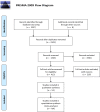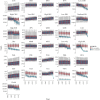Estimates of the global burden of Japanese encephalitis and the impact of vaccination from 2000-2015
- PMID: 32450946
- PMCID: PMC7282807
- DOI: 10.7554/eLife.51027
Estimates of the global burden of Japanese encephalitis and the impact of vaccination from 2000-2015
Abstract
Japanese encephalitis (JE) is a mosquito-borne disease, known for its high mortality and disability rate among symptomatic cases. Many effective vaccines are available for JE, and the use of a recently developed and inexpensive vaccine, SA 14-14-2, has been increasing over the recent years particularly with Gavi support. Estimates of the local burden and the past impact of vaccination are therefore increasingly needed, but difficult due to the limitations of JE surveillance. In this study, we implemented a mathematical modelling method (catalytic model) combined with age-stratifed case data from our systematic review which can overcome some of these limitations. We estimate in 2015 JEV infections caused 100,308 JE cases (95% CI: 61,720-157,522) and 25,125 deaths (95% CI: 14,550-46,031) globally, and that between 2000 and 2015 307,774 JE cases (95% CI: 167,442-509,583) were averted due to vaccination globally. Our results highlight areas that could have the greatest benefit from starting vaccination or from scaling up existing programs and will be of use to support local and international policymakers in making vaccine allocation decisions.
Keywords: epidemiology; global health; human; japanese encephalitis; mathematical modelling; vaccination impact.
© 2020, Quan et al.
Conflict of interest statement
TQ, TT, ND, TN, HC No competing interests declared
Figures









References
-
- Barzaga NG. A review of Japanese Encephalitis cases in the Philippines (1972-1985) The Southeast Asian Journal of Tropical Medicine and Public Health. 1990;20:587–592. - PubMed
-
- Burke DS, Leake CJ. Japanese encephalitis. WHO-Recommended Standards for Surveillance of Selected Vaccine-Preventable Diseases. 1988 https://doi.org/WHO/V&B/03.01
Publication types
MeSH terms
Substances
Grants and funding
LinkOut - more resources
Full Text Sources
Miscellaneous

